photo style transfer
Papers and Code
Generative Artisan: A Semantic-Aware and Controllable CLIPstyler
Jul 23, 2022


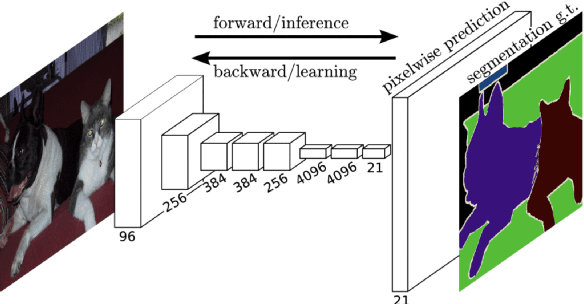
Recall that most of the current image style transfer methods require the user to give an image of a particular style and then extract that styling feature and texture to generate the style of an image, but there are still some problems: the user may not have a reference style image, or it may be difficult to summarise the desired style in mind with just one image. The recently proposed CLIPstyler has solved this problem, which is able to perform style transfer based only on the provided description of the style image. Although CLIPstyler can achieve good performance when landscapes or portraits appear alone, it can blur the people and lose the original semantics when people and landscapes coexist. Based on these issues, we demonstrate a novel framework that uses a pre-trained CLIP text-image embedding model and guides image style transfer through an FCN semantic segmentation network. Specifically, we solve the portrait over-styling problem for both selfies and real-world landscape with human subjects photos, enhance the contrast between the effect of style transfer in portrait and landscape, and make the degree of image style transfer in different semantic parts fully controllable. Our Generative Artisan resolve the failure case of CLIPstyler and yield both qualitative and quantitative methods to prove ours have much better results than CLIPstyler in both selfies and real-world landscape with human subjects photos. This improvement makes it possible to commercialize our framework for business scenarios such as retouching graphics software.
Unsupervised Coherent Video Cartoonization with Perceptual Motion Consistency
Apr 02, 2022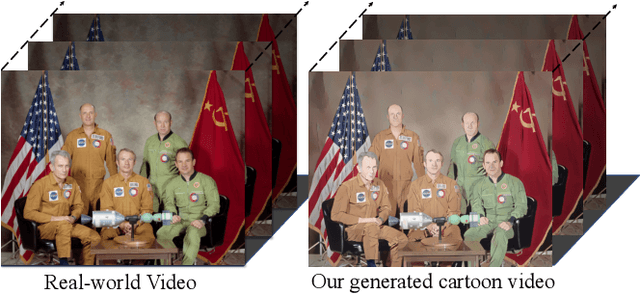



In recent years, creative content generations like style transfer and neural photo editing have attracted more and more attention. Among these, cartoonization of real-world scenes has promising applications in entertainment and industry. Different from image translations focusing on improving the style effect of generated images, video cartoonization has additional requirements on the temporal consistency. In this paper, we propose a spatially-adaptive semantic alignment framework with perceptual motion consistency for coherent video cartoonization in an unsupervised manner. The semantic alignment module is designed to restore deformation of semantic structure caused by spatial information lost in the encoder-decoder architecture. Furthermore, we devise the spatio-temporal correlative map as a style-independent, global-aware regularization on the perceptual motion consistency. Deriving from similarity measurement of high-level features in photo and cartoon frames, it captures global semantic information beyond raw pixel-value in optical flow. Besides, the similarity measurement disentangles temporal relationships from domain-specific style properties, which helps regularize the temporal consistency without hurting style effects of cartoon images. Qualitative and quantitative experiments demonstrate our method is able to generate highly stylistic and temporal consistent cartoon videos.
APRNet: Attention-based Pixel-wise Rendering Network for Photo-Realistic Text Image Generation
Mar 15, 2022


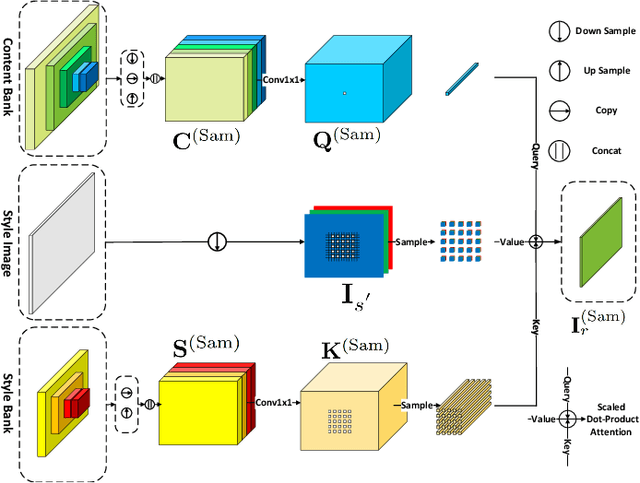
Style-guided text image generation tries to synthesize text image by imitating reference image's appearance while keeping text content unaltered. The text image appearance includes many aspects. In this paper, we focus on transferring style image's background and foreground color patterns to the content image to generate photo-realistic text image. To achieve this goal, we propose 1) a content-style cross attention based pixel sampling approach to roughly mimicking the style text image's background; 2) a pixel-wise style modulation technique to transfer varying color patterns of the style image to the content image spatial-adaptively; 3) a cross attention based multi-scale style fusion approach to solving text foreground misalignment issue between style and content images; 4) an image patch shuffling strategy to create style, content and ground truth image tuples for training. Experimental results on Chinese handwriting text image synthesis with SCUT-HCCDoc and CASIA-OLHWDB datasets demonstrate that the proposed method can improve the quality of synthetic text images and make them more photo-realistic.
PCA-Based Knowledge Distillation Towards Lightweight and Content-Style Balanced Photorealistic Style Transfer Models
Mar 25, 2022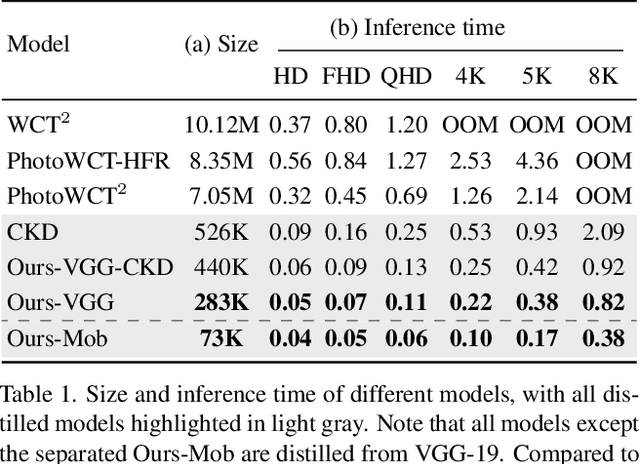
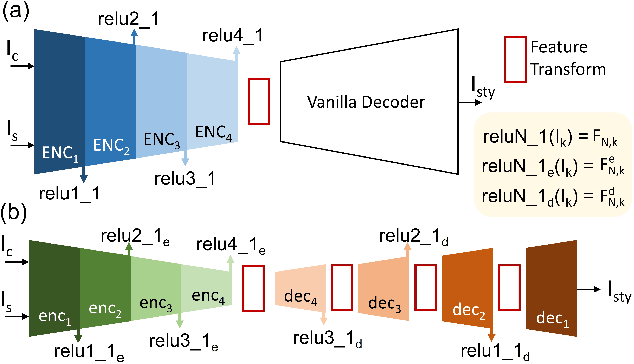


Photorealistic style transfer entails transferring the style of a reference image to another image so the result seems like a plausible photo. Our work is inspired by the observation that existing models are slow due to their large sizes. We introduce PCA-based knowledge distillation to distill lightweight models and show it is motivated by theory. To our knowledge, this is the first knowledge distillation method for photorealistic style transfer. Our experiments demonstrate its versatility for use with different backbone architectures, VGG and MobileNet, across six image resolutions. Compared to existing models, our top-performing model runs at speeds 5-20x faster using at most 1\% of the parameters. Additionally, our distilled models achieve a better balance between stylization strength and content preservation than existing models. To support reproducing our method and models, we share the code at \textit{https://github.com/chiutaiyin/PCA-Knowledge-Distillation}.
3D Photo Stylization: Learning to Generate Stylized Novel Views from a Single Image
Dec 04, 2021
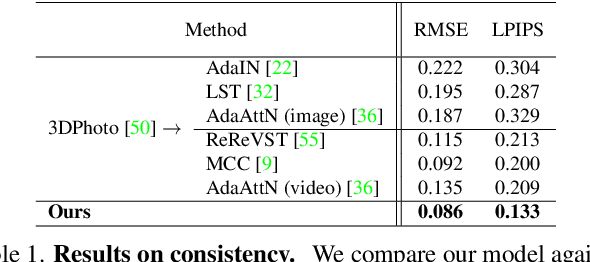


Visual content creation has spurred a soaring interest given its applications in mobile photography and AR / VR. Style transfer and single-image 3D photography as two representative tasks have so far evolved independently. In this paper, we make a connection between the two, and address the challenging task of 3D photo stylization - generating stylized novel views from a single image given an arbitrary style. Our key intuition is that style transfer and view synthesis have to be jointly modeled for this task. To this end, we propose a deep model that learns geometry-aware content features for stylization from a point cloud representation of the scene, resulting in high-quality stylized images that are consistent across views. Further, we introduce a novel training protocol to enable the learning using only 2D images. We demonstrate the superiority of our method via extensive qualitative and quantitative studies, and showcase key applications of our method in light of the growing demand for 3D content creation from 2D image assets.
DCT-Net: Domain-Calibrated Translation for Portrait Stylization
Jul 06, 2022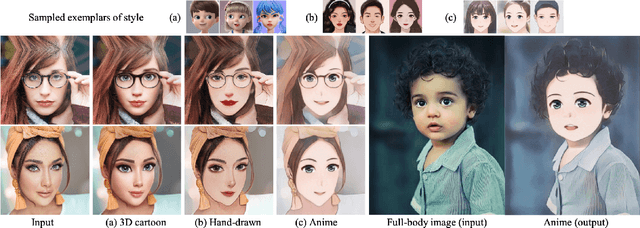


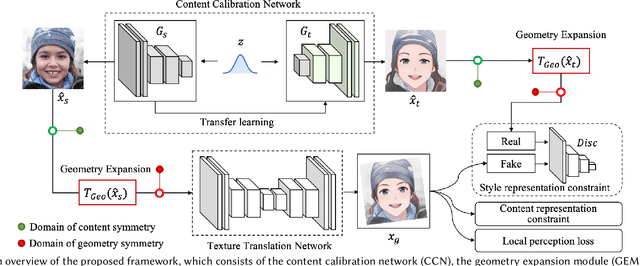
This paper introduces DCT-Net, a novel image translation architecture for few-shot portrait stylization. Given limited style exemplars ($\sim$100), the new architecture can produce high-quality style transfer results with advanced ability to synthesize high-fidelity contents and strong generality to handle complicated scenes (e.g., occlusions and accessories). Moreover, it enables full-body image translation via one elegant evaluation network trained by partial observations (i.e., stylized heads). Few-shot learning based style transfer is challenging since the learned model can easily become overfitted in the target domain, due to the biased distribution formed by only a few training examples. This paper aims to handle the challenge by adopting the key idea of "calibration first, translation later" and exploring the augmented global structure with locally-focused translation. Specifically, the proposed DCT-Net consists of three modules: a content adapter borrowing the powerful prior from source photos to calibrate the content distribution of target samples; a geometry expansion module using affine transformations to release spatially semantic constraints; and a texture translation module leveraging samples produced by the calibrated distribution to learn a fine-grained conversion. Experimental results demonstrate the proposed method's superiority over the state of the art in head stylization and its effectiveness on full image translation with adaptive deformations.
DeepObjStyle: Deep Object-based Photo Style Transfer
Dec 11, 2020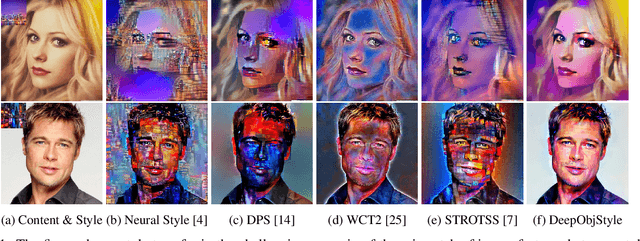


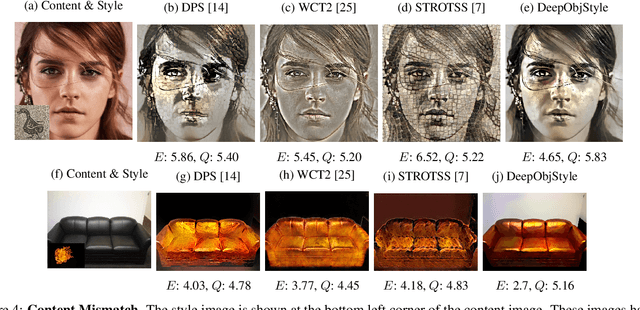
One of the major challenges of style transfer is the appropriate image features supervision between the output image and the input (style and content) images. An efficient strategy would be to define an object map between the objects of the style and the content images. However, such a mapping is not well established when there are semantic objects of different types and numbers in the style and the content images. It also leads to content mismatch in the style transfer output, which could reduce the visual quality of the results. We propose an object-based style transfer approach, called DeepObjStyle, for the style supervision in the training data-independent framework. DeepObjStyle preserves the semantics of the objects and achieves better style transfer in the challenging scenario when the style and the content images have a mismatch of image features. We also perform style transfer of images containing a word cloud to demonstrate that DeepObjStyle enables an appropriate image features supervision. We validate the results using quantitative comparisons and user studies.
Protecting Facial Privacy: Generating Adversarial Identity Masks via Style-robust Makeup Transfer
Mar 28, 2022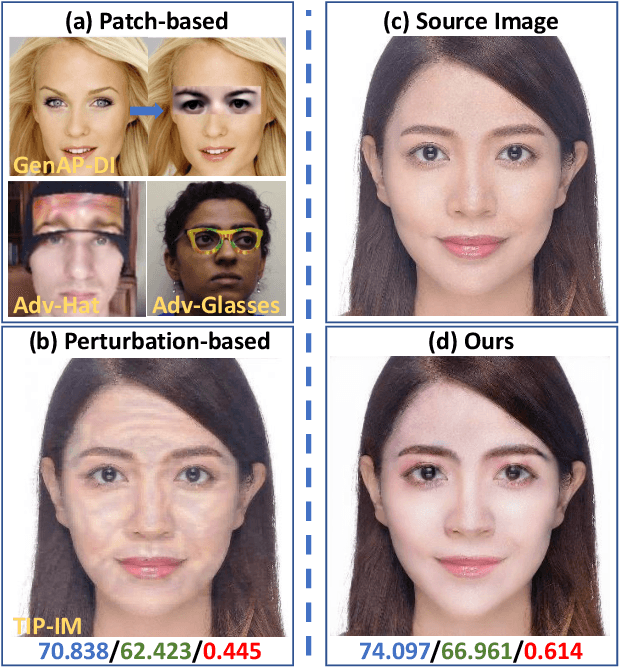

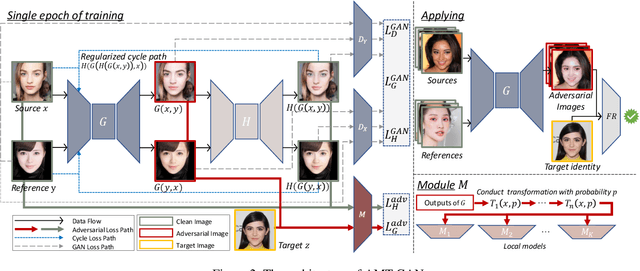
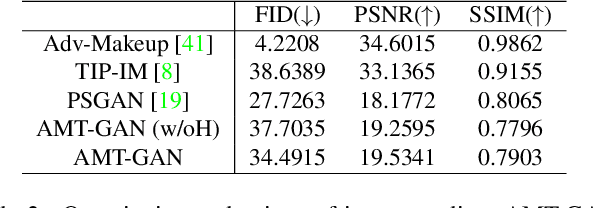
While deep face recognition (FR) systems have shown amazing performance in identification and verification, they also arouse privacy concerns for their excessive surveillance on users, especially for public face images widely spread on social networks. Recently, some studies adopt adversarial examples to protect photos from being identified by unauthorized face recognition systems. However, existing methods of generating adversarial face images suffer from many limitations, such as awkward visual, white-box setting, weak transferability, making them difficult to be applied to protect face privacy in reality. In this paper, we propose adversarial makeup transfer GAN (AMT-GAN), a novel face protection method aiming at constructing adversarial face images that preserve stronger black-box transferability and better visual quality simultaneously. AMT-GAN leverages generative adversarial networks (GAN) to synthesize adversarial face images with makeup transferred from reference images. In particular, we introduce a new regularization module along with a joint training strategy to reconcile the conflicts between the adversarial noises and the cycle consistence loss in makeup transfer, achieving a desirable balance between the attack strength and visual changes. Extensive experiments verify that compared with state of the arts, AMT-GAN can not only preserve a comfortable visual quality, but also achieve a higher attack success rate over commercial FR APIs, including Face++, Aliyun, and Microsoft.
SinIR: Efficient General Image Manipulation with Single Image Reconstruction
Jun 14, 2021

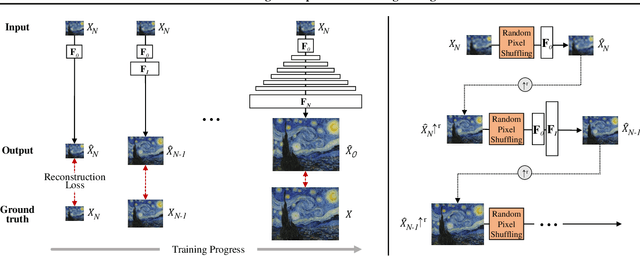
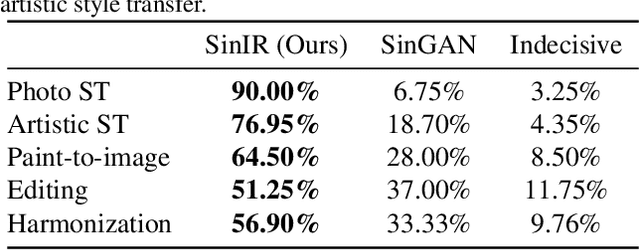
We propose SinIR, an efficient reconstruction-based framework trained on a single natural image for general image manipulation, including super-resolution, editing, harmonization, paint-to-image, photo-realistic style transfer, and artistic style transfer. We train our model on a single image with cascaded multi-scale learning, where each network at each scale is responsible for image reconstruction. This reconstruction objective greatly reduces the complexity and running time of training, compared to the GAN objective. However, the reconstruction objective also exacerbates the output quality. Therefore, to solve this problem, we further utilize simple random pixel shuffling, which also gives control over manipulation, inspired by the Denoising Autoencoder. With quantitative evaluation, we show that SinIR has competitive performance on various image manipulation tasks. Moreover, with a much simpler training objective (i.e., reconstruction), SinIR is trained 33.5 times faster than SinGAN (for 500 X 500 images) that solves similar tasks. Our code is publicly available at github.com/YooJiHyeong/SinIR.
Domain-Aware Universal Style Transfer
Aug 17, 2021


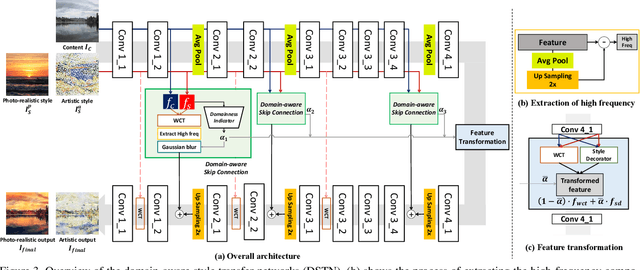
Style transfer aims to reproduce content images with the styles from reference images. Existing universal style transfer methods successfully deliver arbitrary styles to original images either in an artistic or a photo-realistic way. However, the range of 'arbitrary style' defined by existing works is bounded in the particular domain due to their structural limitation. Specifically, the degrees of content preservation and stylization are established according to a predefined target domain. As a result, both photo-realistic and artistic models have difficulty in performing the desired style transfer for the other domain. To overcome this limitation, we propose a unified architecture, Domain-aware Style Transfer Networks (DSTN) that transfer not only the style but also the property of domain (i.e., domainness) from a given reference image. To this end, we design a novel domainness indicator that captures the domainness value from the texture and structural features of reference images. Moreover, we introduce a unified framework with domain-aware skip connection to adaptively transfer the stroke and palette to the input contents guided by the domainness indicator. Our extensive experiments validate that our model produces better qualitative results and outperforms previous methods in terms of proxy metrics on both artistic and photo-realistic stylizations.
 Add to Chrome
Add to Chrome Add to Firefox
Add to Firefox Add to Edge
Add to Edge